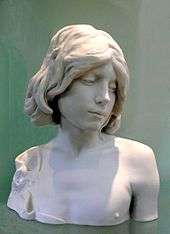Bisque porcelain

Bisque porcelain or bisque is a type of unglazed, white porcelain,[1][2] with a matte appearance and texture to the touch. It has been widely used in European pottery, mainly for objects that are not tableware and so do not need a glaze for protection. Although the term "biscuit" is often used to refer to it, bisque is only a subgroup of unglazed biscuit pottery, which for most pottery is a stage after a first firing before a glaze is applied.
Small figurines and other decorative pieces have often been made in bisque, as well as larger portrait busts and other sculptures; the appearance of bisque is very similar to that of carved and smoothed marble, the traditional prestige material for sculpture in the West. A popular use for bisque porcelain was the manufacture of bisque dolls in the 19th century, where the bisque was typically tinted or painted in flesh tones.[3] Parian ware is a 19th-century type of bisque.
See also
| Wikimedia Commons has media related to Biscuit porcelain. |
References
- ↑ “Kaiser Develops A Growing Niche.” Tableware International. 23,No.7, pg.55-56. 1993.
- ↑ "How bisque porcelain figurine is made - material, manufacture, making, history, used, processing, parts, components, steps, product, industry, History, Raw Materials, Design". madehow.com.
- ↑ Deutsche Zentrale für Tourismus e.V. (7 August 2014). "Tourism in Germany – travel, breaks, holidays" (PDf).